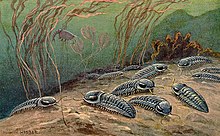Àsíkò Ìgbéàtijọ́
The Paleozoic or Palaeozoic Era (from the Greek palaios (παλαιός), "old" and zoe (ζωή), "life", meaning "ancient life") is the earliest of three geologic eras of the Phanerozoic Eon. The Paleozoic spanned from roughly 542 to 251 ẹgbẹgbẹ̀rún ọdún sẹ́yìn (ICS, 2004), and is subdivided into six geologic periods; from oldest to youngest they are: the Cambrian, Ordovician, Silurian, Devonian, Carboniferous, and Permian. Fish populations exploded in the Devonian. During the late Paleozoic, great forests of primitive plants throve on land forming the great coal beds of Europe and eastern North America. By the end of the era, the first large, sophisticated reptiles and the first modern plants, (conifers) had developed.

| Àyọkà yìí únfẹ́ ìyílédèdà sí Yorùbá. Ẹ ran Wikipedia lọ́wọ́ ṣàtúnṣe sí ìyílédèdà |
| Àsíkò Ìgbéàtijọ́ 542 - 251 ẹgbẹgbẹ̀rún ọdun sẹ́yìn | |
Key events in the Paleozoic An approximate timescale of key Paleozoic events. Axis scale: millions of years ago. |
The Paleozoic Era ended with the largest mass extinction in Earth's history, the Permian-Triassic Extinction Event. The effects of this catastrophe were so devastating that it took life on land 30 million years to recover.[1] Recovery of life in the sea may have been much faster.[2]

|
Àyọkà yìí tàbí apá rẹ̀ únfẹ́ àtúnṣe sí. Ẹ le fẹ̀ jù báyìí lọ tàbí kí ẹ ṣàtúnṣe rẹ̀ lọ́nà tí yíò mu kúnrẹ́rẹ́. Ẹ ran Wikipedia lọ́wọ́ láti fẹ̀ẹ́ jù báyìí lọ. |
Itokasi
àtúnṣe- ↑ Sahney, S. and Benton, M.J. (2008). "Recovery from the most profound mass extinction of all time" (PDF). Proceedings of the Royal Society: Biological 275 (1636): 759–65. doi:10.1098/rspb.2007.1370. PMC 2596898. PMID 18198148. http://journals.royalsociety.org/content/qq5un1810k7605h5/fulltext.pdf.
- ↑ url=http://www.economist.com/node/16524904
| Preceded by Proterozoic Eon | 542 Ma - Phanerozoic Eon - Present | |||||||||||
|---|---|---|---|---|---|---|---|---|---|---|---|---|
| 542 Ma - Paleozoic Era - 251 Ma | 251 Ma - Mesozoic Era - 65 Ma | 65 Ma - Cenozoic Era - Present | ||||||||||
| Kámbríà | Ọ̀rdòfísíà | Sílúríà | Dẹfoníà | Eléèédú | Pẹ́rmíà | Tríásíkì | Jùrásíkì | Ẹlẹ́fun | Ìbíniàtijọ́ | Ìbíniọ̀tun | Quaternary | |